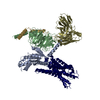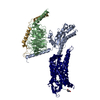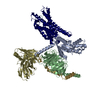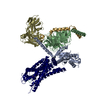+Search query
-Structure paper
| Title | Structure-based design of non-hypertrophic apelin receptor modulator. |
|---|---|
| Journal, issue, pages | Cell, Vol. 187, Issue 6, Page 1460-1475.e20, Year 2024 |
| Publish date | Mar 14, 2024 |
 Authors Authors | Wei-Wei Wang / Su-Yu Ji / Wenjia Zhang / Junxia Zhang / Chenxi Cai / Rubi Hu / Shao-Kun Zang / Luwei Miao / Haomang Xu / Li-Nan Chen / Zongkuai Yang / Jia Guo / Jiao Qin / Dan-Dan Shen / Ping Liang / Yan Zhang / Yan Zhang /  |
| PubMed Abstract | Apelin is a key hormone in cardiovascular homeostasis that activates the apelin receptor (APLNR), which is regarded as a promising therapeutic target for cardiovascular disease. However, adverse ...Apelin is a key hormone in cardiovascular homeostasis that activates the apelin receptor (APLNR), which is regarded as a promising therapeutic target for cardiovascular disease. However, adverse effects through the β-arrestin pathway limit its pharmacological use. Here, we report cryoelectron microscopy (cryo-EM) structures of APLNR-G complexes bound to three agonists with divergent signaling profiles. Combined with functional assays, we have identified "twin hotspots" in APLNR as key determinants for signaling bias, guiding the rational design of two exclusive G-protein-biased agonists WN353 and WN561. Cryo-EM structures of WN353- and WN561-stimulated APLNR-G protein complexes further confirm that the designed ligands adopt the desired poses. Pathophysiological experiments have provided evidence that WN561 demonstrates superior therapeutic effects against cardiac hypertrophy and reduced adverse effects compared with the established APLNR agonists. In summary, our designed APLNR modulator may facilitate the development of next-generation cardiovascular medications. |
 External links External links |  Cell / Cell /  PubMed:38428423 PubMed:38428423 |
| Methods | EM (single particle) |
| Resolution | 2.6 - 3.2 Å |
| Structure data | EMDB-38794, PDB-8xzf: EMDB-38795, PDB-8xzg: EMDB-38796, PDB-8xzh: EMDB-38797, PDB-8xzi: EMDB-38798, PDB-8xzj: |
| Chemicals |  PDB-1d5n: |
| Source |
|
 Keywords Keywords |  MEMBRANE PROTEIN / APLNR / Class A GPCR / MEMBRANE PROTEIN / APLNR / Class A GPCR /  Synthetic peptide / apelin / Synthetic peptide / apelin /  Structural protein / MM07 / Structural protein / MM07 /  Cyclic peptide / CMF-019 / G-protein-biased small molecule agonist Cyclic peptide / CMF-019 / G-protein-biased small molecule agonist |
 Movie
Movie Controller
Controller Structure viewers
Structure viewers About Yorodumi Papers
About Yorodumi Papers














